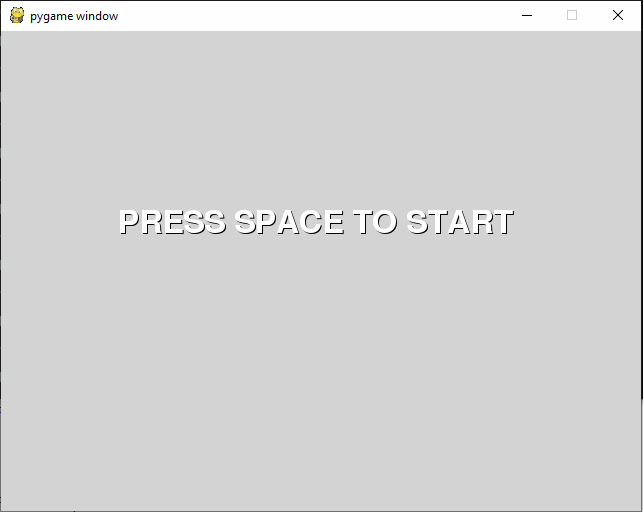Let's start with a new, basic pygame program. I usually start like this:
import pygame
def main():
screen = pygame.display.set_mode((640, 480))
clock = pygame.time.Clock()
dt = 0
while True:
events = pygame.event.get()
for e in events:
if e.type == pygame.QUIT:
return
screen.fill(pygame.Color('lightgrey'))
pygame.display.flip()
dt = clock.tick(60)
if __name__ == '__main__':
main()
Not much to see here. We create a window, paint it grey, handle events and keep track of the delta time (the time each frame takes).
Let's also think a moment of how the game is supposed to work. First, we have a title screen, then we select a difficulty, then we show some questions, and finally, we display the result. We call each of those parts a scene, and we jump from one to another.
Here's a way we could implement these:
import pygame
import pygame.freetype
class SimpleScene:
FONT = None
def __init__(self, text, next_scene):
self.background = pygame.Surface((640, 480))
self.background.fill(pygame.Color('lightgrey'))
if text:
if SimpleScene.FONT == None:
SimpleScene.FONT = pygame.freetype.SysFont(None, 32)
SimpleScene.FONT.render_to(self.background, (120, 180), text, pygame.Color('black'))
SimpleScene.FONT.render_to(self.background, (119, 179), text, pygame.Color('white'))
self.next_scene = next_scene
def start(self):
pass
def draw(self, screen):
screen.blit(self.background, (0, 0))
def update(self, events, dt):
for event in events:
if event.type == pygame.KEYDOWN:
if event.key == pygame.K_SPACE:
return self.next_scene
def main():
pygame.init()
screen = pygame.display.set_mode((640, 480))
clock = pygame.time.Clock()
dt = 0
scenes = {
'TITLE': SimpleScene('PRESS SPACE TO START', 'GAME'),
'GAME': SimpleScene('Can you press [SPACE]', 'RESULT'),
'RESULT': SimpleScene('You win! 100 points!', 'TITLE'),
}
scene = scenes['TITLE']
while True:
events = pygame.event.get()
for e in events:
if e.type == pygame.QUIT:
return
next_scene = scene.update(events, dt)
if next_scene:
scene = scenes[next_scene]
scene.start()
scene.draw(screen)
pygame.display.flip()
dt = clock.tick(60)
if __name__ == '__main__':
main()

We can now transition between the scenes by pressing space. As you can see, each scene is like a miniature game itself; of course we only have the SimpleScene that does nothing but draw a simple text, so let's change that and implement the real game. We also have a game state, so we need to keep track if it, too.
Here's how it could look like:
import pygame
import pygame.freetype
import random
class SimpleScene:
FONT = None
def __init__(self, next_scene, *text):
self.background = pygame.Surface((640, 480))
self.background.fill(pygame.Color('lightgrey'))
y = 80
if text:
if SimpleScene.FONT == None:
SimpleScene.FONT = pygame.freetype.SysFont(None, 32)
for line in text:
SimpleScene.FONT.render_to(self.background, (120, y), line, pygame.Color('black'))
SimpleScene.FONT.render_to(self.background, (119, y-1), line, pygame.Color('white'))
y += 50
self.next_scene = next_scene
self.additional_text = None
def start(self, text):
self.additional_text = text
def draw(self, screen):
screen.blit(self.background, (0, 0))
if self.additional_text:
y = 180
for line in self.additional_text:
SimpleScene.FONT.render_to(screen, (120, y), line, pygame.Color('black'))
SimpleScene.FONT.render_to(screen, (119, y-1), line, pygame.Color('white'))
y += 50
def update(self, events, dt):
for event in events:
if event.type == pygame.KEYDOWN:
if event.key == pygame.K_SPACE:
return (self.next_scene, None)
class GameState:
def __init__(self, difficulty):
self.difficulty = difficulty
self.questions = [
('How many legs has a cow?', 4),
('How many legs has a bird?', 2),
('What is 1 x 1 ?', 1)
]
self.current_question = None
self.right = 0
self.wrong = 0
def pop_question(self):
q = random.choice(self.questions)
self.questions.remove(q)
self.current_question = q
return q
def answer(self, answer):
if answer == self.current_question[1]:
self.right += 1
else:
self.wrong += 1
def get_result(self):
return f'{self.right} answers correct', f'{self.wrong} answers wrong', '', 'Good!' if self.right > self.wrong else 'You can do better!'
class SettingScene:
def __init__(self):
self.background = pygame.Surface((640, 480))
self.background.fill(pygame.Color('lightgrey'))
if SimpleScene.FONT == None:
SimpleScene.FONT = pygame.freetype.SysFont(None, 32)
SimpleScene.FONT.render_to(self.background, (120, 50), 'Select your difficulty level', pygame.Color('black'))
SimpleScene.FONT.render_to(self.background, (119, 49), 'Select your difficulty level', pygame.Color('white'))
self.rects = []
x = 120
y = 120
for n in range(4):
rect = pygame.Rect(x, y, 80, 80)
self.rects.append(rect)
x += 100
def start(self, *args):
pass
def draw(self, screen):
screen.blit(self.background, (0, 0))
n = 1
for rect in self.rects:
if rect.collidepoint(pygame.mouse.get_pos()):
pygame.draw.rect(screen, pygame.Color('darkgrey'), rect)
pygame.draw.rect(screen, pygame.Color('darkgrey'), rect, 5)
SimpleScene.FONT.render_to(screen, (rect.x+30, rect.y+30), str(n), pygame.Color('black'))
SimpleScene.FONT.render_to(screen, (rect.x+29, rect.y+29), str(n), pygame.Color('white'))
n+=1
def update(self, events, dt):
for event in events:
if event.type == pygame.MOUSEBUTTONDOWN:
n = 1
for rect in self.rects:
if rect.collidepoint(event.pos):
return ('GAME', GameState(n))
n += 1
class GameScene:
def __init__(self):
if SimpleScene.FONT == None:
SimpleScene.FONT = pygame.freetype.SysFont(None, 32)
self.rects = []
x = 120
y = 120
for n in range(4):
rect = pygame.Rect(x, y, 80, 80)
self.rects.append(rect)
x += 100
def start(self, gamestate):
self.background = pygame.Surface((640, 480))
self.background.fill(pygame.Color('lightgrey'))
self.gamestate = gamestate
question, answer = gamestate.pop_question()
SimpleScene.FONT.render_to(self.background, (120, 50), question, pygame.Color('black'))
SimpleScene.FONT.render_to(self.background, (119, 49), question, pygame.Color('white'))
def draw(self, screen):
screen.blit(self.background, (0, 0))
n = 1
for rect in self.rects:
if rect.collidepoint(pygame.mouse.get_pos()):
pygame.draw.rect(screen, pygame.Color('darkgrey'), rect)
pygame.draw.rect(screen, pygame.Color('darkgrey'), rect, 5)
SimpleScene.FONT.render_to(screen, (rect.x+30, rect.y+30), str(n), pygame.Color('black'))
SimpleScene.FONT.render_to(screen, (rect.x+29, rect.y+29), str(n), pygame.Color('white'))
n+=1
def update(self, events, dt):
for event in events:
if event.type == pygame.MOUSEBUTTONDOWN:
n = 1
for rect in self.rects:
if rect.collidepoint(event.pos):
self.gamestate.answer(n)
if self.gamestate.questions:
return ('GAME', self.gamestate)
else:
return ('RESULT', self.gamestate.get_result())
n += 1
def main():
pygame.init()
screen = pygame.display.set_mode((640, 480))
clock = pygame.time.Clock()
dt = 0
scenes = {
'TITLE': SimpleScene('SETTING', 'Welcome to the quiz', '', '', '', 'press [SPACE] to start'),
'SETTING': SettingScene(),
'GAME': GameScene(),
'RESULT': SimpleScene('TITLE', 'Here is your result:'),
}
scene = scenes['TITLE']
while True:
events = pygame.event.get()
for e in events:
if e.type == pygame.QUIT:
return
result = scene.update(events, dt)
if result:
next_scene, state = result
if next_scene:
scene = scenes[next_scene]
scene.start(state)
scene.draw(screen)
pygame.display.flip()
dt = clock.tick(60)
if __name__ == '__main__':
main()

Of course it's not 100% finished, but it should give you an idea on how to structure your game to get what you want.
As you can see, each scene handles its own aspect of the game, and the game scene jumps to itself while passing the game state. To add a timer, you can simply store the current game time (e.g. pygame.time.get_ticks()) in the game state the first time its start function is called, and calculate the remaining time in the update function of the scene. If the timer runs out, jump to a scene that displays the result.
